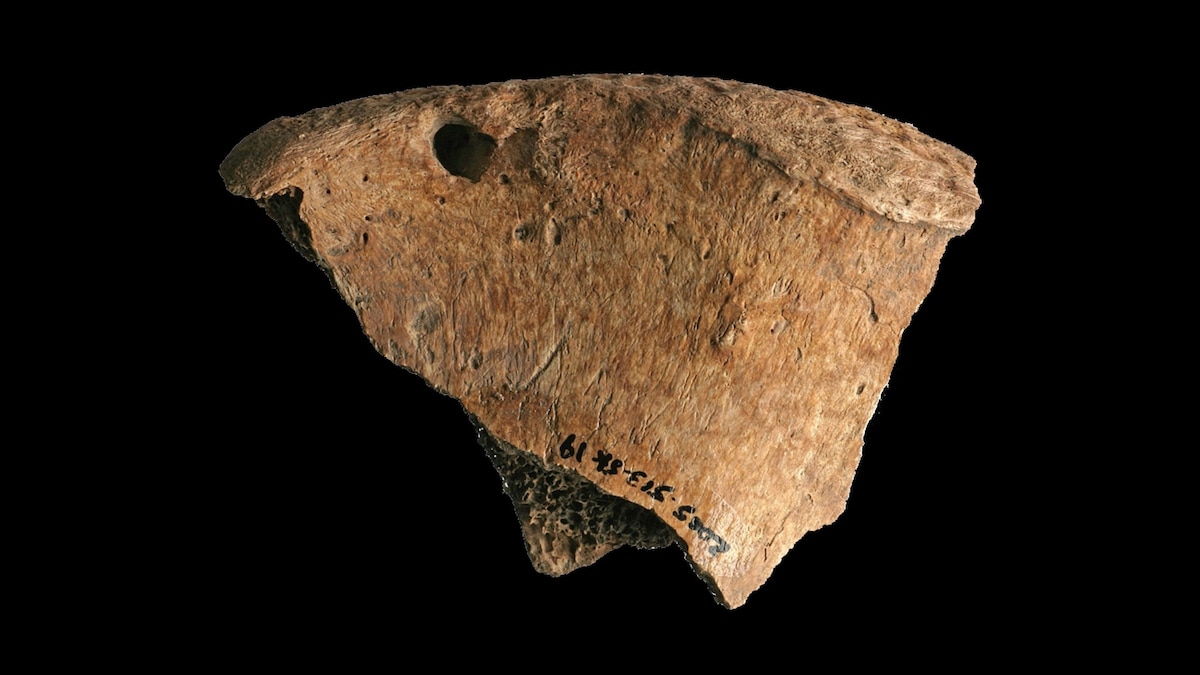Now Reading: The best evidence yet that Roman gladiators fought lions: a bite mark
-
01
The best evidence yet that Roman gladiators fought lions: a bite mark
The best evidence yet that Roman gladiators fought lions: a bite mark

Gladiators fighting lions is among the more enduring images of the arenas of ancient Rome. But other than depictions in mosaics and carvings, along with a few mentions in ancient texts, there is virtually no physical evidence that it actually occurred. Until now.
For the first time, bite marks made by a large cat, possibly an African lion, have been identified on the bones of what is believed to be a gladiator who died nearly 1,800 years ago. The remains found 20 years ago in a Roman-era graveyard in York, England, were recently reexamined by British researchers to determine the cause of the puncture wounds.
(What Hollywood gets wrong—and right—about Roman gladiators.)
The individual is “the only person in the Roman world” to be found with bite marks made by an apex predator such as a lion, says archaeologist John Pearce of King’s College London, a member of the team behind the study that published in the journal PLOS One. It’s also the first physical evidence that big cats were brought into this far-flung corner of the Roman Empire for arena games.

Was the hole in this human bone made by the jaws of a lion? Researchers compared the specimen found in a Roman-era cemetery to bite marks made by modern-day big cats—and discovered it was clearly made by either a lion or a leopard.
Photograph courtesy Thompson TJU, Errickson D, McDonnell C, Holst M, Caffell A, Pearce J, et al. (2025)
The researchers compared high-resolution 3D scans of the bite marks to those made by modern-day big cats after they were fed meat on a bone. “Through a process of elimination, [the bites] are clearly either a lion or a leopard,” Pearce says.
Tim Thompson, a forensic anthropologist at Maynooth University in Ireland who led the study team, believes the bite marks were caused around the time of death—meaning that this isn’t a case of a lion gnawing on the bones of someone who had long been dead.
“There is no evidence of healing, which would indicate [the bite happened before death],” he says in an email. “If they were postmortem we would expect to see a different color on the edge of the fractures caused by the biting as well as the loss of the small pieces of bone within the punctures.”
What’s less clear is whether the deceased was actually a gladiator or someone else who died fighting a lion in a Roman arena. But experts say it does reveal a richer picture of how these violent spectacles unfolded.
A cemetery for gladiators?
The skeleton was discovered 20 years ago in Eboracum, or present-day York. Eboracum was an important Roman fortress and city in the Roman province of Britannia from A.D. 71 to 400. This individual likely died and was buried in the middle to late third century A.D., according to researchers who examined the soil strata.
(How Roman gladiators got ready to rumble.)
Though no headstones or other signage was discovered at the cemetery, the study team believes it was the burial site of gladiators. Most of the nearly 70 remains discovered there show signs of “violent encounters” that would have been typical of gladiators. Many were also decapitated—a common ritual for those badly wounded during gladiatorial combat in England.
“We found decapitation to be the case for so many other skeletons in the cemetery, it seems to be a coup de grâce thing for the loser,” Pearce says.
However, some experts have questioned the assertation.
You May Also Like
“Technically, gladiators fought against gladiators,” says Michael Carter, a professor in Greek and Roman history and Latin at Brock University in Ontario. “It could be a venatore, a beast hunter or beast fighter, someone who specialized in fighting against large cats and bears. More likely, I think it was a criminal condemned to death in the arena.”
In ancient Rome, damnatio ad bestias—Latin for “condemnation to beasts”—was a common form of punishment for criminals, Christians, and others at arenas before gladiatorial games. It may also have been used as a form of religious sacrifice, as University of Arizona historian Alison Futrell wrote in her book The Roman Games.
The remains were most likely that of a venatore, agrees author and historian Barry Strauss, the Bryce and Edith M. Bowmar Professor in Humanistic Studies at Cornell University. However, as he noted in an email, Eboracum would have been at the edge of the Roman empire.
(How to see the remains of ancient Rome in modern-day Britain.)
“The rules they followed in Rome were not necessarily applied in godforsaken Eboracum. So, although the man was probably not a gladiator, he may indeed have been one. Burial in the gladiator cemetery is certainly an argument in favor of that theory.”
“Whatever the case, we can confidently say that a violent encounter between human and big cat in York is only ever going to happen in an arena,” Pearce says.
Big cats in England
So how did an African lion or any other big cat end up in England in the first place? It’s not as farfetched as it may seem.
Eboracum was home to the 6th Legion of the Roman Empire, which had several soldiers who came from North Africa. In fact, Pearce notes Roman-era pottery discovered in York features design elements associated with that region, suggesting that African craftsmen accompanied the legion when it occupied Brittania.
“Occasionally, the emperor shows up,” he says. “We know Septimus Severus visited there about this time. It is conceivable that a lion could have been sent to York for a major spectacle or even just to entertain the troops.”
Lions weren’t cheap, though. An edict by Emperor Diocletian in A.D. 301 capped the cost of a lion from North Africa at 150,000 denarii, a common Roman silver coin. Dominic Rathbone, a professor of ancient history at King’s College London, writes in an email that this sum is “somewhere in the £250-500K ($330,000 to $600,000) range as the modern equivalent cost for a lion.”
A high price to pay—but worth it in a world that highly valued such spectacles as a form of entertainment.
Ultimately the new findings are of immense value to archaeologists and historians studying the legends surrounding gladiatorial games and animal hunts at amphitheaters across the Roman Empire. Researchers hope this discovery will provide impetus for locating the Eboracum amphitheater, which still lies buried somewhere under York.
“To me, it’s totally fascinating,” Carter says. “It’s kind of confirming what we knew, but it’s super interesting to find one that we can now talk about.”




















